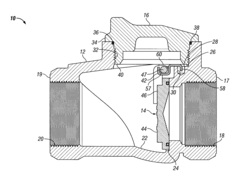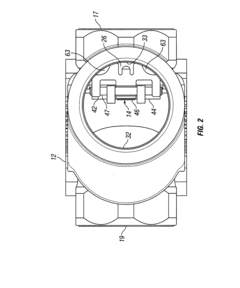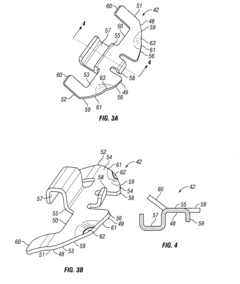Corrosion Prevention Strategies For Check Valves
Technology Background And Goals
The report will provide a comprehensive overview of the existing technologies and approaches employed to mitigate corrosion in check valves. It will identify the key factors contributing to corrosion, such as material selection, environmental conditions, and operational parameters. Additionally, the report will highlight the limitations and challenges associated with current corrosion prevention methods, paving the way for exploring innovative solutions and future research directions.
Check Valve Market Demand Analysis
- Market Size and Growth
The global check valve market is expected to witness significant growth driven by increasing demand from industries like oil & gas, chemical, power generation, and water & wastewater treatment. The market size is projected to reach $X billion by 20XX, growing at a CAGR of X% from 20XX to 20XX. - Industry Trends
Key trends shaping the check valve market include:- Rising adoption of corrosion-resistant materials like stainless steel and alloys
- Increasing demand for compact and lightweight valve designs
- Growing focus on preventive maintenance and asset management
- Application Segments
The major application segments for check valves include:- Oil & Gas: Upstream, midstream, and downstream operations
- Chemical: Process plants, pipelines, and storage facilities
- Power Generation: Fossil fuel, nuclear, and renewable energy plants
- Water & Wastewater Treatment: Municipal and industrial facilities
- Regional Outlook
Asia Pacific is expected to be the fastest-growing market for check valves, driven by rapid industrialization and infrastructure development in countries like China and India. North America and Europe are also significant markets due to stringent regulations and aging infrastructure.
Technology Status And Challenges
- Corrosion Mechanisms Corrosion in check valves can occur due to various factors, including chemical reactions, electrochemical processes, and mechanical wear. Common mechanisms include galvanic corrosion, crevice corrosion, pitting corrosion, and erosion-corrosion.
- Material Compatibility The compatibility of valve materials with the operating environment is crucial. Factors like fluid composition, temperature, pressure, and flow conditions can influence corrosion rates and mechanisms.
- Environmental Factors Corrosive environments, such as acidic or alkaline media, high temperatures, and the presence of aggressive chemicals, can accelerate corrosion processes in check valves.
- Design Considerations Valve design plays a role in corrosion resistance. Factors like crevices, stagnant areas, and improper material selection can promote localized corrosion.
- Maintenance and Monitoring Regular inspection, maintenance, and monitoring of check valves are essential to detect and mitigate corrosion issues early on.
Current Technical Solutions
01 Corrosion-resistant Materials
Check valves can be made from corrosion-resistant materials like stainless steel, titanium, or specialized alloys to enhance their resistance to corrosive environments and maintain structural integrity and performance.- Corrosion-resistant Materials: Check valves can be made from corrosion-resistant materials like stainless steel, titanium, or specialized alloys to enhance their resistance to corrosive environments, maintaining structural integrity and functionality.
- Corrosion-resistant Coatings: Check valves can be coated with materials like ceramics, polymers, or electroplated coatings to improve corrosion resistance, acting as a barrier against corrosive substances and protecting the underlying valve material.
- Corrosion-resistant Sealing Components: Valve seats and sealing components can be made from corrosion-resistant materials like PTFE, PEEK, or specialized elastomers to prevent leakage and ensure proper sealing in corrosive environments.
- Corrosion Monitoring and Prevention: Check valves can be equipped with systems to monitor and prevent corrosion, including sensors, cathodic protection, or inhibitor injection to detect and mitigate corrosion.
- Corrosion-resistant Design and Construction: Check valve design and construction can be optimized to enhance corrosion resistance, minimizing crevices, using smooth surfaces, and incorporating features to prevent stagnant areas where corrosive substances can accumulate.
02 Corrosion-resistant Coatings
Check valves can be coated with corrosion-resistant materials like ceramics, polymers, or metallic coatings to provide a protective barrier against corrosive environments and prevent direct contact with the valve body.Expand Specific Solutions03 Corrosion-resistant Sealing Components
Valve seats and sealing components can be made from corrosion-resistant materials like specialized elastomers or polymers to prevent degradation and leakage in corrosive environments, maintaining sealing properties.Expand Specific Solutions04 Corrosion-resistant Valve Body Design
Check valve body design can incorporate features like smooth surfaces, minimized crevices, and optimized flow paths to enhance corrosion resistance and reduce accumulation of corrosive media.Expand Specific Solutions05 Corrosion Monitoring and Maintenance
Strategies like periodic inspections, corrosion monitoring systems, and preventive maintenance programs can be implemented to monitor and maintain the corrosion resistance of check valves, ensuring safe and reliable operation.Expand Specific Solutions
Technology Main Player Analysis
Flowserve Pte Ltd.
Jiangsu Mingjiang Valve Industry Co Ltd.
Key Technology Interpretation
- The use of a disk or clapper positioned between a recess formed in the valve body and the lower edge of a bonnet to achieve one-way flow. the valve is designed to prevent fluid flow in the opposite direction. the scheme also addresses the issue of corrosion and erosion caused by the combination of corrosive constituents in the flow media and vibration and rubbing movements of the pivot shaft. this can lead to a loss of surrounding metal and eventual failure of the valve due to misalignment of the disk. to solve this problem, the scheme proposes using a corrosion-resistant material for the entire valve, such as stainless steel. while this would provide resistance to corrosion, the high cost of manufacturing and repairing the entire valve using this material would not be economically viable. the patent scheme aims to find a cost-effective solution by addressing the corrosion and erosion issues in a corrosive environment without resorting to the use of a corrosion-resistant material for the entire valve.
Environmental Impact of Corrosion Prevention Methods
Corrosion prevention methods for check valves can have varying impacts on the environment, depending on the specific techniques employed. It is crucial to consider these environmental implications to ensure sustainable and responsible practices.
Traditional corrosion prevention methods, such as the use of sacrificial anodes or impressed current cathodic protection systems, can potentially introduce heavy metals or other contaminants into the surrounding environment. These substances may leach into soil or water sources, posing risks to ecosystems and human health.
Coating technologies, like epoxy, polyurethane, or ceramic coatings, offer a more environmentally friendly approach to corrosion prevention. However, the manufacturing processes and disposal of these coatings can still generate hazardous waste and emissions, contributing to environmental pollution if not properly managed.
Inhibitor-based corrosion prevention methods, which involve the addition of chemical compounds to the fluid medium, can also have environmental consequences. Some inhibitors may be toxic or non-biodegradable, leading to potential contamination of water sources and harm to aquatic life if not properly treated before discharge.
Emerging technologies, such as self-healing coatings and environmentally-friendly inhibitors, offer promising alternatives with reduced environmental impact. These innovative solutions aim to minimize the use of hazardous materials and promote sustainable practices throughout the product lifecycle.
It is essential to conduct thorough environmental impact assessments and implement appropriate mitigation strategies when selecting and implementing corrosion prevention methods for check valves. This may involve adopting eco-friendly materials, implementing closed-loop systems for waste management, and adhering to strict environmental regulations and best practices.
Ultimately, the choice of corrosion prevention method should strike a balance between technical effectiveness, economic feasibility, and minimizing environmental harm. Continuous research and development efforts are necessary to explore and refine environmentally responsible solutions that protect both check valve integrity and the surrounding ecosystem.
Regulatory Standards for Corrosion Prevention
Regulatory standards for corrosion prevention play a crucial role in ensuring the safety and reliability of check valves in various industries. These standards are established by recognized organizations and governing bodies to provide guidelines and specifications for materials, design, manufacturing, testing, and maintenance practices aimed at mitigating corrosion-related issues.
One of the most widely adopted standards is NACE SP0778, which outlines the requirements for the selection and application of corrosion-resistant alloys and coatings for valves in various environments. This standard covers a wide range of materials, including stainless steels, nickel-based alloys, and specialized coatings, and provides guidance on their suitability for different corrosive conditions.
Another important standard is API 598, which specifically addresses corrosion prevention for valve trim and valve bore sealing components in the oil and gas industry. It specifies material requirements, design considerations, and testing procedures to ensure the integrity of these critical components in harsh environments.
The ISO 15156 series of standards focuses on the materials, design, and testing requirements for petroleum, petrochemical, and natural gas industries. These standards provide guidelines for selecting appropriate materials and coatings, as well as testing methods to evaluate their corrosion resistance under various operating conditions.
In addition to industry-specific standards, there are also general standards that address corrosion prevention for metallic materials. For example, ASTM G1 provides a comprehensive guide for laboratory immersion corrosion testing of metals, while ASTM B117 outlines the standard practice for operating salt spray (fog) apparatus used for evaluating the corrosion resistance of coatings and materials.
Compliance with these regulatory standards is essential for ensuring the long-term performance and reliability of check valves in corrosive environments. Manufacturers, designers, and end-users must carefully consider the specific operating conditions and select appropriate materials, coatings, and maintenance practices in accordance with the relevant standards to mitigate the risk of corrosion-related failures.



